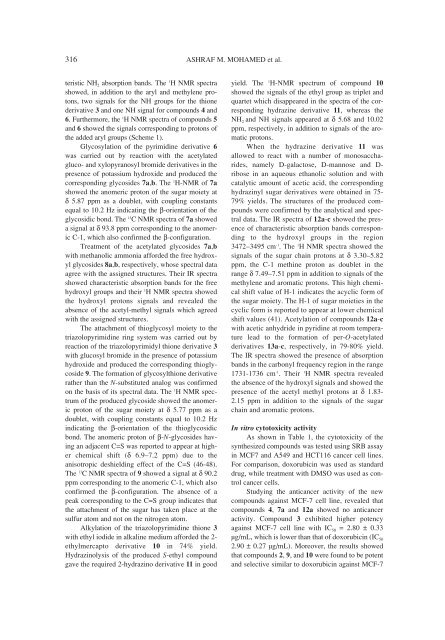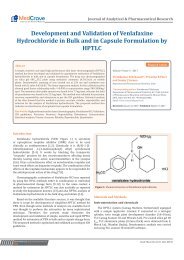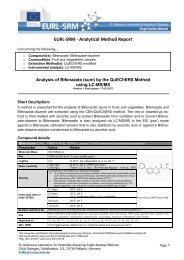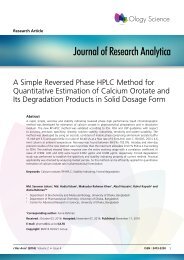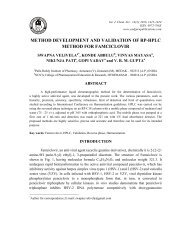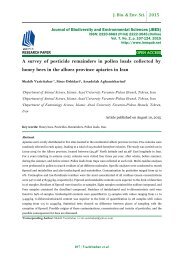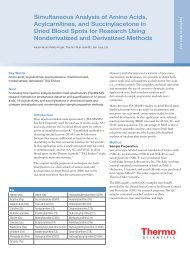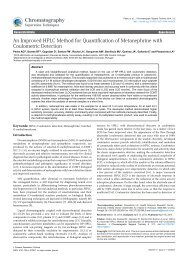acta 2_2015
acta 2_2015
acta 2_2015
- No tags were found...
Create successful ePaper yourself
Turn your PDF publications into a flip-book with our unique Google optimized e-Paper software.
316 ASHRAF M. MOHAMED et al.teristic NH 2 absorption bands. The 1 H NMR spectrashowed, in addition to the aryl and methylene protons,two signals for the NH groups for the thionederivative 3 and one NH signal for compounds 4 and6. Furthermore, the 1 H NMR spectra of compounds 5and 6 showed the signals corresponding to protons ofthe added aryl groups (Scheme 1).Glycosylation of the pyrimidine derivative 6was carried out by reaction with the acetylatedgluco- and xylopyranosyl bromide derivatives in thepresence of potassium hydroxide and produced thecorresponding glycosides 7a,b. The 1 H-NMR of 7ashowed the anomeric proton of the sugar moiety atδ 5.87 ppm as a doublet, with coupling constantsequal to 10.2 Hz indicating the β-orientation of theglycosidic bond. The 13 C NMR spectra of 7a showeda signal at δ 93.8 ppm corresponding to the anomericC-1, which also confirmed the β-configuration.Treatment of the acetylated glycosides 7a,bwith methanolic ammonia afforded the free hydroxylglycosides 8a,b, respectively, whose spectral dataagree with the assigned structures. Their IR spectrashowed characteristic absorption bands for the freehydroxyl groups and their 1 H NMR spectra showedthe hydroxyl protons signals and revealed theabsence of the acetyl-methyl signals which agreedwith the assigned structures.The attachment of thioglycosyl moiety to thetriazolopyrimidine ring system was carried out byreaction of the triazolopyrimidyl thione derivative 3with glucosyl bromide in the presence of potassiumhydroxide and produced the corresponding thioglycoside9. The formation of glycosylthione derivativerather than the N-substituted analog was confirmedon the basis of its spectral data. The 1 H NMR spectrumof the produced glycoside showed the anomericproton of the sugar moiety at δ 5.77 ppm as adoublet, with coupling constants equal to 10.2 Hzindicating the β-orientation of the thioglycosidicbond. The anomeric proton of β-N-glycosides havingan adjacent C=S was reported to appear at higherchemical shift (δ 6.9ñ7.2 ppm) due to theanisotropic deshielding effect of the C=S (46-48).The 13 C NMR spectra of 9 showed a signal at δ 90.2ppm corresponding to the anomeric C-1, which alsoconfirmed the β-configuration. The absence of apeak corresponding to the C=S group indicates thatthe attachment of the sugar has taken place at thesulfur atom and not on the nitrogen atom.Alkylation of the triazolopyrimidine thione 3with ethyl iodide in alkaline medium afforded the 2-ethylmercapto derivative 10 in 74% yield.Hydrazinolysis of the produced S-ethyl compoundgave the required 2-hydrazino derivative 11 in goodyield. The 1 H-NMR spectrum of compound 10showed the signals of the ethyl group as triplet andquartet which disappeared in the spectra of the correspondinghydrazine derivative 11, whereas theNH 2 and NH signals appeared at δ 5.68 and 10.02ppm, respectively, in addition to signals of the aromaticprotons.When the hydrazine derivative 11 wasallowed to react with a number of monosaccharides,namely D-galactose, D-mannose and D-ribose in an aqueous ethanolic solution and withcatalytic amount of acetic acid, the correspondinghydrazinyl sugar derivatives were obtained in 75-79% yields. The structures of the produced compoundswere confirmed by the analytical and spectraldata. The IR spectra of 12a-c showed the presenceof characteristic absorption bands correspondingto the hydroxyl groups in the region3472ñ3495 cm -1 . The 1 H NMR spectra showed thesignals of the sugar chain protons at δ 3.30ñ5.82ppm, the C-1 methine proton as doublet in therange δ 7.49ñ7.51 ppm in addition to signals of themethylene and aromatic protons. This high chemicalshift value of H-1 indicates the acyclic form ofthe sugar moiety. The H-1 of sugar moieties in thecyclic form is reported to appear at lower chemicalshift values (41). Acetylation of compounds 12a-cwith acetic anhydride in pyridine at room temperaturelead to the formation of per-O-acetylatedderivatives 13a-c, respectively, in 79-80% yield.The IR spectra showed the presence of absorptionbands in the carbonyl frequency region in the range1731-1736 cm -1 . Their 1 H NMR spectra revealedthe absence of the hydroxyl signals and showed thepresence of the acetyl methyl protons at δ 1.83-2.15 ppm in addition to the signals of the sugarchain and aromatic protons.In vitro cytotoxicity activityAs shown in Table 1, the cytotoxicity of thesynthesized compounds was tested using SRB assayin MCF7 and A549 and HCT116 cancer cell lines.For comparison, doxorubicin was used as standarddrug, while treatment with DMSO was used as controlcancer cells.Studying the anticancer activity of the newcompounds against MCF-7 cell line, revealed thatcompounds 4, 7a and 12a showed no anticanceractivity. Compound 3 exhibited higher potencyagainst MCF-7 cell line with IC 50 = 2.80 ± 0.33µg/mL, which is lower than that of doxorubicin (IC 502.90 ± 0.27 µg/mL). Moreover, the results showedthat compounds 2, 9, and 10 were found to be potentand selective similar to doxorubicin against MCF-7


